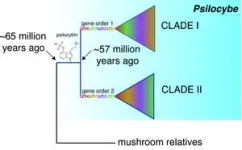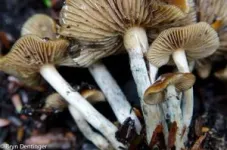(Press-News.org) Astronomers using NASA’s James Webb Space Telescope have found a brown dwarf (an object more massive than Jupiter but smaller than a star) with infrared emission from methane, likely due to energy in its upper atmosphere. This is an unexpected discovery because the brown dwarf, W1935, is cold and lacks a host star; therefore, there is no obvious source for the upper atmosphere energy. The team speculates that the methane emission may be due to processes generating aurorae.
These findings are being presented at the 243rd meeting of the American Astronomical Society in New Orleans.
To help explain the mystery of the infrared emission from methane, the team turned to our solar system. Methane in emission is a common feature in gas giants like Jupiter and Saturn. The upper-atmosphere heating that powers this emission is linked to aurorae.
On Earth, aurorae are created when energetic particles blown into space from the Sun are captured by Earth’s magnetic field. They cascade down into our atmosphere along magnetic field lines near Earth’s poles, colliding with gas molecules and creating eerie, dancing curtains of light. Jupiter and Saturn have similar auroral processes that involve interacting with the solar wind, but they also get auroral contributions from nearby active moons like Io (for Jupiter) and Enceladus (for Saturn).
For isolated brown dwarfs like W1935, the absence of a stellar wind to contribute to the auroral process and explain the extra energy in the upper atmosphere required for the methane emission is a mystery. The team surmises that either unaccounted internal processes like the atmospheric phenomena of Jupiter and Saturn, or external interactions with either interstellar plasma or a nearby active moon, may help account for the emission.
A Detective Story
The aurorae’s discovery played out like a detective story. A team led by Jackie Faherty, an astronomer at the American Museum of Natural History in New York, was awarded time with the Webb telescope to investigate 12 cold brown dwarfs. Among those were W1935 – an object that was discovered by citizen scientist Dan Caselden, who worked with the Backyard Worlds zooniverse project – and W2220, an object that was discovered using NASA’s Wide Field Infrared Survey Explorer. Webb revealed in exquisite detail that W1935 and W2220 appeared to be near clones of each other in composition. They also shared similar brightness, temperatures, and spectral features of water, ammonia, carbon monoxide, and carbon dioxide. The striking exception was that W1935 showed emission from methane, as opposed to the anticipated absorption feature that was observed toward W2220. This was seen at a distinct infrared wavelength to which Webb is uniquely sensitive.
“We expected to see methane because methane is all over these brown dwarfs. But instead of absorbing light, we saw just the opposite: The methane was glowing. My first thought was, what the heck? Why is methane emission coming out of this object?” said Faherty.
The team used computer models to infer what might be behind the emission. The modeling work showed that W2220 had an expected distribution of energy throughout the atmosphere, getting cooler with increasing altitude. W1935, on the other hand, had a surprising result. The best model favored a temperature inversion, where the atmosphere got warmer with increasing altitude. “This temperature inversion is really puzzling,” said Ben Burningham, a co-author from the University of Hertfordshire in England and lead modeler on the work. “We have seen this kind of phenomenon in planets with a nearby star that can heat the stratosphere, but seeing it in an object with no obvious external heat source is wild.”
Clues from our Solar System
For clues, the team looked in our own backyard, to the planets of our solar system. The gas giant planets can serve as proxies for what is seen going on more than 40 light-years away in the atmosphere of W1935.
The team realized that temperature inversions are prominent in planets like Jupiter and Saturn. There is still ongoing work to understand the causes of their stratospheric heating, but leading theories for the solar system involve external heating by aurorae and internal energy transport from deeper in the atmosphere (with the former a leading explanation).
Brown Dwarf Aurora Candidates in Context
This is not the first time an aurora has been used to explain a brown dwarf observation. Astronomers have detected radio emission coming from several warmer brown dwarfs and invoked aurorae as the most likely explanation. Searches were conducted with ground-based telescopes like the Keck Observatory for infrared signatures from these radio-emitting brown dwarfs to further characterize the phenomenon, but were inconclusive.
W1935 is the first auroral candidate outside the solar system with the signature of methane emission. It’s also the coldest auroral candidate outside our solar system, with an effective temperature of about 400 degrees Fahrenheit (200 degrees Celsius), about 600 degrees Fahrenheit warmer than Jupiter.
In our solar system the solar wind is a primary contributor to auroral processes, with active moons like Io and Enceladus playing a role for planets like Jupiter and Saturn, respectively. W1935 lacks a companion star entirely, so a stellar wind cannot contribute to the phenomenon. It is yet to be seen whether an active moon might play a role in the methane emission on W1935.
“With W1935, we now have a spectacular extension of a solar system phenomenon without any stellar irradiation to help in the explanation.” Faherty noted. “With Webb, we can really ‘open the hood’ on the chemistry and unpack how similar or different the auroral process may be beyond our solar system,” she added.
The James Webb Space Telescope is the world’s premier space science observatory. Webb is solving mysteries in our solar system, looking beyond to distant worlds around other stars, and probing the mysterious structures and origins of our universe and our place in it. Webb is an international program led by NASA with its partners, ESA (European Space Agency) and the Canadian Space Agency.
END
NASA’s Webb finds signs of possible aurorae on isolated brown dwarf
2024-01-09
ELSE PRESS RELEASES FROM THIS DATE:
Meagan Brem and team receive grant to study alcohol-fueled acts of violence among intimate partners
2024-01-09
Beer pong. Quarters. Flip cup. The drinking games college students play can seem like an alcohol-laced version of intramural sports.
When college-aged drinkers imbibe too heavily, the risk for physically harming a romantic partner rises considerably.
What if there was a way for heavy drinkers to monitor their alcoholic intake and blood-alcohol levels in real time, before an intimate situation cascades into physical violence?
Or, as Virginia Tech researcher and assistant professor of psychology Meagan Brem put it: “If we can identify ...
Unlocking the secrets of a "hot Saturn" and its spotted star
2024-01-09
Led by researchers from Université de Montréal's Trottier Institute for Research on Exoplanets (iREx), a team of astronomers has harnessed the power of the revolutionary James Webb Space Webb Telescope (JWST) to study the "hot Saturn" exoplanet HAT-P-18 b.
Their findings, published last month in the journal Monthly Notices of the Royal Astronomical Society, paint a complete picture of the HAT-P-18 b's atmosphere while exploring the great challenge of distinguishing its atmospheric signals from the activity of its star.
HAT-P-18 b is located over 500 light-years away ...
RSV shown to infect nerve cells, cause inflammation and damage
2024-01-09
Respiratory syncytial virus (RSV), a common infection in children and senior adults, can also infect nerve cells and trigger inflammation leading to nerve damage, according to a new Tulane University study.
RSV can cause mild symptoms such as coughing, sneezing and fever or lead to more severe conditions such as pneumonia or bronchiolitis. But since the disease was first discovered in 1956, it has been thought to only infect the respiratory tract.
This study, published in The Journal of Infectious Diseases, is the first to prove that RSV can penetrate nerve cells and may provide the ...
A common marker of neurological diseases may play role in healthy brains
2024-01-09
https://www.ninds.nih.gov/news-events/press-releases/common-marker-neurological-diseases-may-play-role-healthy-brainsResearchers have discovered that a protein called phosphorylated α-synuclein, which is associated with several neurodegenerative diseases such as Parkinson’s disease and Lewy body dementia, is also involved in the normal processes of how neurons communicate with each other in a healthy brain. The research, published in Neuron, was funded in part by the National Institute of Neurological Disorders and Stroke (NINDS), a part of the National Institutes of Health.
Phosphorylation is a process where a phosphate ...
ChatGPT poem regurgitation raises ethical questions
2024-01-09
ITHACA, N.Y. – Ask ChatGPT to find a well-known poem and it will probably regurgitate the entire text verbatim – regardless of copyright law – according to a new study by Cornell University researchers.
The study showed that ChatGPT was capable of “memorizing” poems, especially famous ones commonly found online. The findings pose ethical questions about how ChatGPT and other proprietary artificial intelligence models are trained – likely using data scraped from the internet, researchers said.
“It’s generally not good for large language models to memorize large chunks of text, in part because it’s a privacy concern,” ...
Sickle cell raises COVID-19 risk, but vaccination lags
2024-01-09
Despite the fact that people with sickle cell disease have a much higher risk of serious illness or death if they develop COVID-19, a new study shows they’re also much less likely than those without sickle cell disease to have gotten vaccinated against coronavirus.
Completion of the initial COVID-19 vaccination series was nearly two times lower for adults with sickle cell disease as others their age, the analysis of data in Michigan shows.
In in teens and children over 5, who overall have lower rates of COVID-19 vaccination, those with sickle cell disease were far less likely than other young people to have gotten their doses by summer 2022, the analysis ...
Brookline Housing Authority partners with Hebrew SeniorLife for health and social services in senior housing
2024-01-09
The Brookline Housing Authority (BHA) has partnered with Hebrew SeniorLife, New England’s largest nonprofit provider of senior health care and living communities, and the only senior care organization affiliated with Harvard Medical School, to provide community life services including resident services, fitness, social programming, and nursing in BHA’s senior housing sites.
Hebrew SeniorLife brings to the BHA its model of housing with services called the Right Care, Right Place, Right Time (R3) program. This model uses a preventive approach to resident services, focused on one-on-one relationship building, community-wide ...
Sylvester-led research group unveils the first individual risk prediction model for multiple myeloma
2024-01-09
MIAMI, FLORIDA (EMBARGOED UNTIL JAN. 9, 2024 AT 4 PM EST) – A multicenter collaboration led by researchers at Sylvester Comprehensive Cancer Center at the University of Miami Miller School of Medicine has produced the first computational model for newly diagnosed multiple myeloma that predicts an individual’s personalized prognosis based on their tumor genomics and treatments.
The prediction model for individualized risk in newly diagnosed multiple myeloma, or IRMMa, improves on previous prognostic tools because it takes into account ...
Systemic changes induced by ASCOT in plasma proteome of women with impaired ovarian reserves
2024-01-09
“Identifying plasma proteins that regenerate aged or damaged ovaries could lead to more effective, targeted and/or preventive therapies for patients.”
BUFFALO, NY- January 9, 2024 – A new research paper was published in Aging (listed by MEDLINE/PubMed as "Aging (Albany NY)" and "Aging-US" by Web of Science) Volume 15, Issue 24, entitled, “Systemic changes induced by autologous stem cell ovarian transplant in plasma proteome of women with impaired ovarian reserves.”
Patients with poor ...
Green wheels, bright skies: NREL analysis unveils the connection between electric vehicles and photovoltaics
2024-01-09
People who own electric vehicles (EVs) are more likely to go a step further and add solar panels to their home, according to an analysis of a behavioral study by researchers at the U.S. Department of Energy’s National Renewable Energy Laboratory (NREL). Conversely, the impact of owning solar panels also has a bearing on whether a homeowner buys an electric vehicle but not as strongly.
The study relied on a survey of 869 households in the San Francisco Bay Area.
NREL’s Shivam Sharda, lead author of the newly published research paper that analyzes the ...






